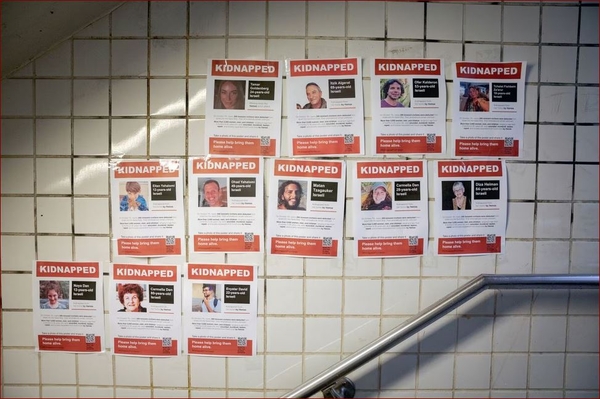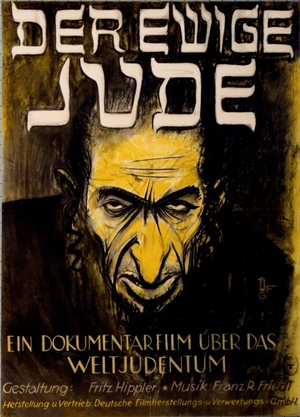 Fliers showing the faces of Jews kidnapped by Hamas were affixed to a wall in a subway station in New York on Oct. 14. |
A CAT from my neighborhood has gone missing. Her owner has distributed fliers around the area, asking residents to keep an eye out for her. "LOST CAT," it says in big letters beneath a photo of Coco, a beautiful animal with fluffy white fur and blue eyes.
Whether the fliers will lead to Coco's recovery I don't know. But of one thing I am certain: No one walking through the neighborhood will be grabbing all the posters and stuffing them in the trash. Even people who dislike cats wouldn't be that callous and mean.
But ever since fliers calling attention to something far more terrible than a missing cat — the plight of the more than 200 hostages abducted from Israel by Hamas on Oct. 7 — began going up on telephone poles, subway walls, utility boxes, and worksite fences in cities around the world, a startling number of people have been eager to tear them down. Individuals have been filmed destroying or defacing the posters in Boston, London, Miami, New York, Melbourne, Philadelphia, Richmond, Ann Arbor, and Los Angeles.
There is no possible justification for such heartlessness. The whole purpose of the fliers is to heighten awareness of the Israeli (and other) civilians kidnapped by the Hamas terror squads — to put names and faces to the hostages, all with one goal: to bring them back home. How can a project so heartfelt and humane trigger such a poisonous response?
The posters were the brainchild of two Israeli artists, Nitzan Mintz and Dede Bandaid, who were visiting New York when Hamas carried out its bloodbath. Aching to help in some way, they drew on their art backgrounds to design the eye-catching fliers. Each is topped with the word "KIDNAPPED" in large white letters on an orange background; below that heading is the name, age, nationality, and photo of one of the hostages, who range in age from 3 months to 85 years.
The posters went viral overnight. Within days they were appearing everywhere, a powerful symbol of Israel's anguish and of the desperate yearning for the captives' safe return. Then came the backlash. "Within minutes or hours of going up," reported the New York Jewish Week, "many of them had been partially ripped off the subway station's walls, tears obscuring the victims' faces or details about their lives, while others were defaced with marker or surrounded by messages such as "Free Palestine." On a poster of two of the youngest hostages, 3-year-old twins Emma and Yuli Cunio, Hitler mustaches were drawn on the girls' faces. On other posters, the words "Lies" or "Actors" were scrawled.
Those ripping down or damaging the signs are by no means abashed about doing so. Some have filmed themselves attacking the fliers and posted the video online. Others, when asked why they were trashing the pictures of civilian hostages, have yelled about "genocide," declared their support for "Palestinian civilians," claimed the fliers contained "inaccurate information," or simply cursed out the person filming them.
The Israeli-Palestinian conflict is intensely controversial and generates great emotion on both sides. But these assaults on the "Kidnapped" posters have nothing to do with the merits of the dispute. The sole purpose of the fliers is to emphasize the humanity of the innocent hostages seized by Hamas (many of whom, as it happens, were peace activists deeply committed to Arab-Israeli coexistence). What drives the people ripping down the posters or adding Hitler mustaches to the pictures is a pathological need to deny the humanity of those kidnapped Jews.
A core principle of antisemites in all times and places is that Jews are not fully human and are never innocent. A thousand years ago, Jews were slaughtered by Crusaders for being satanic Christ-killers who consumed the blood of children; a century ago Hitler preached that they were subhumans who polluted the racial purity of Aryan Europe. Today the Jewish state is accused of committing the demonic crimes of genocide and apartheid. The poison never changes, only the vial it comes in.
The "Kidnapped" fliers are intolerable to the haters because they so urgently challenge the antisemitic paradigm. They make it vividly clear that in the war between barbarism and civilization, between oppressor and oppressed, it is Jews who are under attack. That infuriates those whose worldview revolves around the certainty that Israel and its supporters are the victimizers. The outpouring of sympathy for Jews kidnapped by Palestinian terrorists — and the moral force of that sympathy — is anathema to them.
That explains as well why the atrocities committed on Oct. 7 immediately triggered so many vehement public demonstrations in support of the Palestinians. Precisely because the massacre and abductions had been so unspeakably horrific, it was necessary to reinforce the narrative of Jewish villainy. At times, denunciations of Israel gave way to naked antisemitsm. At a pro-Palestinian rally in Sydney, a chorus of voices chanted "Gas the Jews! F*** the Jews!" Others expressed their hatred by rejoicing in the slaughter of Israelis. A professor at Cornell, for example, told a crowd he was "exhilarated" by what Hamas had done.
 A core principle of antisemites in all times and places is that Jews are not fully human and are never innocent. |
In the wake of terrible mass shootings like the one that took at least 18 lives and convulsed Lewiston, Maine, on Wednesday, grieving family and friends often display pictures of their loved ones. It is a way of reinforcing the humanity of the victims and of evoking compassion from passersby. Who, seeing such a display, would destroy or vandalize it? Some norms are so ingrained as to be all but inviolable. When someone puts up an image of a missing or murdered child, no decent person rips it down.
But antisemitism has the power to override every norm and decent impulse.
On Reddit last week, a commenter explained that coming across a "Kidnapped" flier made him feel not empathy with the hostage, but "the exact opposite." It filled him with "white hot rage," he wrote, and he decided that "ripping it down and tearing it to shreds is the only thing I can do."
The ripped-up fliers are one more indication of the rising tide of antisemitism in America and the West. A "white hot rage" is building. I, for one, cannot shake the conviction that Jews are at graver risk than they have been in decades, and not only in southern Israel.
(Jeff Jacoby is a columnist for The Boston Globe).
-- ## --
Follow Jeff Jacoby on X (aka Twitter).
Discuss his columns on Facebook.
Want to read more? Sign up for "Arguable," Jeff Jacoby's free weekly email newsletter.

